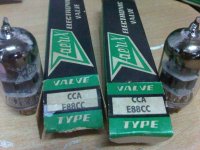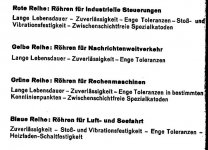Hi all, I am new here.
I am a very new in tube amplifier, I bought car tube amplifier with 2 (two) 6N11 tube inside, the sound is very bright, then I bought at local store 2 Zaerix CCA-E88CC - Z&I Aero Services LTD London - England for USD.80/each, this is gold pin, the gold is not shine but look like heavily coat not shine gold .
My car sound is warm now, love it.
I understand that Zaerix is a military supplier for tube, they rebranded many tube, I was looking in internet for this tube information, but I didn't find one.
The store has 4 stocks last for this tubes/valves, is it worth to buy this tubes/valves at that price?
Anybody know what the origin manufacture of this tube/valve Zaerix CCA-E88CC ?
Thank in Advance,
Kesha
I am a very new in tube amplifier, I bought car tube amplifier with 2 (two) 6N11 tube inside, the sound is very bright, then I bought at local store 2 Zaerix CCA-E88CC - Z&I Aero Services LTD London - England for USD.80/each, this is gold pin, the gold is not shine but look like heavily coat not shine gold .
My car sound is warm now, love it.
I understand that Zaerix is a military supplier for tube, they rebranded many tube, I was looking in internet for this tube information, but I didn't find one.
The store has 4 stocks last for this tubes/valves, is it worth to buy this tubes/valves at that price?
Anybody know what the origin manufacture of this tube/valve Zaerix CCA-E88CC ?
Thank in Advance,
Kesha
Attachments
@The Manta, yes, I love the tube sound for my car audio system, I really love the very warm, wet and look like carpet room effect from this Zaerix Tube.
The original 6N11 is very bright.
I wonder how the tube can do that like a magic, now I am thinking to get Telefunken, but they are expensive.
Btw, why the Zaerix wrote this valve as CCA ?
They want to fool people or something?
kesha
The original 6N11 is very bright.
I wonder how the tube can do that like a magic, now I am thinking to get Telefunken, but they are expensive.
Btw, why the Zaerix wrote this valve as CCA ?
They want to fool people or something?
kesha
Valve rebranders can sometimes be 'flexible' in their labelling; if it has the same pinout and vaguely similar characteristics then it is fair game to be regarded as an 'equivalent' in their eyes. I once bought a set of 5 12AY7; two of them were 12AY7, the other three were actually 5965 (=12AV7?) but, hey, same pinout and similar mu.
@The Manta, yes, I love the tube sound for my car audio system, I really love the very warm, wet and look like carpet room effect from this Zaerix Tube.
The original 6N11 is very bright.
I wonder how the tube can do that like a magic, now I am thinking to get Telefunken, but they are expensive.
Btw, why the Zaerix wrote this valve as CCA ?
They want to fool people or something?
kesha
No, the German governmental telecommunication office used its own designators for tubes. They didn't use new constructions but standad types like the ECC88. To ensure quality, they used special selected types directly from the factory which were labeld differently. This is how the Aa, Ba, F2a, CCa etc. were born. The CCa is a ECC88/E88CC used for wide band telecommunication equipment. Zearix simply "faked" that and labeld them also as CCa but with a Capital "A".
Here is a pic I made long ago with all the ECC88 stuff, but basically the same valve.
An externally hosted image should be here but it was not working when we last tested it.
When I did some listening tests long ago I couldn't hear a difference.
BTW: The tube on the right is russian 6N23P as yours, but relabeld by Richardson (=NATIONAL). That Company also did some scary sh*t like labeling a russian 6P3S as EL156 (http://www.proradioantic.ro/data/anunturi/1295735288.jpg) etc. Rebranded Tubes can be funny from time to time.
Probably galvanic plating afterwards. Generally, one didn't use golden Pins in the manufacturing process of a tube because gold doesn't bond to silicon dioxide glass very well. (Glass-to-metal seal - Wikipedia, the free encyclopedia)
Western Countries used a chromium-iron alloy for the pins whereas russians used nickel (shiny bright pins).
I don't really care for gold pins. If you swap a tube a few times, the extremely thin gold coating will come off pretty fast. Especially when you use sockets with bifurcated contacts. Since "tube rolling" is becoming a new sub-culture it should be noted, that gold pin tubes weren't used for swapping around. The were put in once and had to last a long time. I posted an example of an antenna amplifier here: http://www.diyaudio.com/forums/tubes-valves/205870-6922-6dj8-replacement.html#post2889813
The "magic" is of course only some difference in the parameters in the tube contributing to different curves. Ears are a very good analyzer for that
Western Countries used a chromium-iron alloy for the pins whereas russians used nickel (shiny bright pins).
I don't really care for gold pins. If you swap a tube a few times, the extremely thin gold coating will come off pretty fast. Especially when you use sockets with bifurcated contacts. Since "tube rolling" is becoming a new sub-culture it should be noted, that gold pin tubes weren't used for swapping around. The were put in once and had to last a long time. I posted an example of an antenna amplifier here: http://www.diyaudio.com/forums/tubes-valves/205870-6922-6dj8-replacement.html#post2889813
The "magic" is of course only some difference in the parameters in the tube contributing to different curves. Ears are a very good analyzer for that
Yes, Valvo red series are higher quality for special purposes. There are red, green, yellow and blue labeld Valvo tubes.
A scan is in the attachement.
Red Series: Tubes for industrial control systems
long lifetime, reliability, narrow tolerances, shock proof, no cathode interface layer (can be just heated for a long time without losing emission)
Yellow Series: Tubes for long distance telecommunication
long lifetime, reliability, narrow tolerances
Green Series: Tubes for Computers/Calculators
long lifetime, reliability, narrow tolerances in certain operating areas, no cathode interface layer (can be just heated for a long time without losing emission)
Blue Series: Tubes for aviation and maritime purposes
reliability, shock proof, narrow tolerances, high switching capability of filament
If the red E88CC is a special selected E88CC (which is already a selected ECC88) or just labeled red...I don't know
Marketing strategies were well developed, even 60 years ago !
A scan is in the attachement.
Red Series: Tubes for industrial control systems
long lifetime, reliability, narrow tolerances, shock proof, no cathode interface layer (can be just heated for a long time without losing emission)
Yellow Series: Tubes for long distance telecommunication
long lifetime, reliability, narrow tolerances
Green Series: Tubes for Computers/Calculators
long lifetime, reliability, narrow tolerances in certain operating areas, no cathode interface layer (can be just heated for a long time without losing emission)
Blue Series: Tubes for aviation and maritime purposes
reliability, shock proof, narrow tolerances, high switching capability of filament
If the red E88CC is a special selected E88CC (which is already a selected ECC88) or just labeled red...I don't know
Marketing strategies were well developed, even 60 years ago !
Attachments
Thank you for the knowledges, the Manta.
Here is another, yesterday, I met a seller, I bought a pair of used ECC88 Mullard pin gold, then he showed me used Siemen CCa, he wants to sell for usd.200,--/pair.
But the paint smeared, only little showed that is Cca.
But I noticed that the top of the tube is unique, it has lines.
Picture attached.
What do you think, buy or not buy?
Thank you again.
Here is another, yesterday, I met a seller, I bought a pair of used ECC88 Mullard pin gold, then he showed me used Siemen CCa, he wants to sell for usd.200,--/pair.
But the paint smeared, only little showed that is Cca.
But I noticed that the top of the tube is unique, it has lines.
Picture attached.
What do you think, buy or not buy?
Thank you again.
An externally hosted image should be here but it was not working when we last tested it.
Well, i can't tell you whether to buy or not, but it look genuine. These lines come from the molding-matrices.
Just check some Pics here:
Siemens-CCa
Siemens-E88CC
>What do you think, buy or not buy?
Personally, I would never pay 200$ for a tube which I could get much cheaper from new production. It's your decision. Just think about that there is the JJ E88CC from actual production which costs less 1/10 of that.....(JJ E88CC / 6922)
Just check some Pics here:
Siemens-CCa
Siemens-E88CC
>What do you think, buy or not buy?
Personally, I would never pay 200$ for a tube which I could get much cheaper from new production. It's your decision. Just think about that there is the JJ E88CC from actual production which costs less 1/10 of that.....(JJ E88CC / 6922)
The Manta, I have another detail pic for the Zaerix:
Compare to Mullard (righ-smaller), the Zaerix is fatter.
Compare to Mullard (righ-smaller), the Zaerix is fatter.
An externally hosted image should be here but it was not working when we last tested it.
An externally hosted image should be here but it was not working when we last tested it.
Thank Vincent,
But these Zaerix is much better compared to Mullard ECC88, I did the test.
I am looking for its origin in Russian, but still no information, because there are no gold pin in russian tubes.
If the Zaerix valve is apparently "better" than the Mullard one, then there should be some measurable difference.
Are you able to measure voltages? If so, then measure the voltages in the circuit on each valve after it has had time to stabilise, say ten minutes in operation.
The results could be interesting.
Paul
- Status
- This old topic is closed. If you want to reopen this topic, contact a moderator using the "Report Post" button.
- Home
- Amplifiers
- Tubes / Valves
- Help me to Identify this Tube

